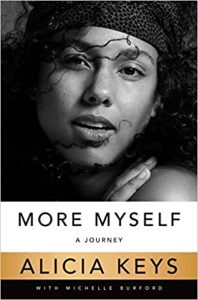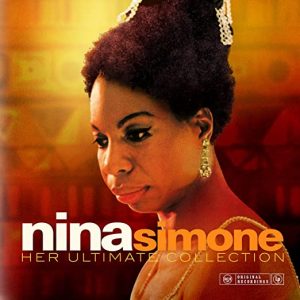Nina & Alicia
2020! This crazy year has disrupted my lifelong fascination with music by European men of the 18th & 19th centuries and schooled me on music by Black women of the 20th and 21st centuries. What all my favorite music has in common is PIANO! After recording Florence Price’s Nimble Feet, I plunged into the music of Nina Simone and Alicia Keys, kicked off by watching a documentary in Netflix’s Black Lives Matter collection, What Happened, Miss Simone?
My only previous experience with her music was a Simone tribute concert Steve and I attended with Louise and Ken Marshall at George Washington University’s Lisner Auditorium in the 1990s. Shelby says she loved to listen to a CD I brought home from that concert.
Nina Simone, was born Eunice Kathleen Waymon on February 21, 1933 in Tryon, North Carolina. Demonstrating early talent on piano, she performed at her church and presented a classical recital when she was 12. Simone later said that during this performance, her parents, who had taken seats in the front row, were forced to move to the back of the hall to make way for white people. She said that she refused to play until her parents were moved back to the front. That was 1945; she was an activist ahead of her times.
Simone studied briefly at Juilliard, but her application to Curtis Institute in Philadelphia, where her family had moved, was turned down. (Shortly before her death in 2003, Curtis granted her an honorary degree.) In order to fund private lessons with a Curtis teacher, Simone performed at the Midtown Bar & Grill in Atlantic City, New Jersey, whose owner insisted that she sing as well as play the piano, which increased her income to $90 a week.
In 1954, she adopted the stage name “Nina Simone”. “Nina”, derived from niña, was a nickname given to her by a boyfriend named Chico, and “Simone” was taken from the French actress Simone Signoret, whom she had seen in the 1952 movie Casque d’Or. Knowing her mother would not approve of playing “the Devil’s music”, she used her new stage name to remain undetected. It will be fun to discuss this Nina with my dear friend Nina Pitkin and to introduce my granddaughter Nina Smith and her twin sister Margot to Nina Simone’s music!
Her style fused gospel and pop with classical music, particularly Bach, as in “Love Me or Leave Me”. The title song of her 1959 debut album, Little Girl Blue, shows how she combined an ancient Christmas carol with a character from a nursery rhyme to created a soulful reflection on the vagaries of love.
By 1965 she became an icon of Civil Rights, and proclaimed truths that few others dared. Here are more interesting facts about her life.
The day after seeing the film I visited the new Boynton Beach City Library, practically empty, and happened on to Alicia Keys’ newly published book, More Myself: a Journey. I had heard of Alicia, but hadn’t closely listened until I started the book and couldn’t put it down. Another classically trained pianist who could sing and compose!
 Alicia Augello Cook was born January 25, 1981 in the Hell’s Kitchen neighborhood of New York City. Her mother was Italian and her father, African American. Like Nina Simone, Keys discovered her passion for the piano when a friend gave her an old, upright piano. (One of my jobs in the MusicLink Foundation was placing donated pianos in the homes of deserving children.) By age seven, she was practicing six hours a day, learning the classics by the Suzuki method. At twelve, Keys enrolled in New York’s Professional Performing Arts School , where she studied music, dance, choir, and theater. She graduated from high school as valedictorian at sixteen, and began attending Columbia University. After a month she decided to drop out of college to pursue music full-time. She had already attracted the attention of recording company executives and had adopted Alicia Keys as a particularly appropriate stage name.
Alicia Augello Cook was born January 25, 1981 in the Hell’s Kitchen neighborhood of New York City. Her mother was Italian and her father, African American. Like Nina Simone, Keys discovered her passion for the piano when a friend gave her an old, upright piano. (One of my jobs in the MusicLink Foundation was placing donated pianos in the homes of deserving children.) By age seven, she was practicing six hours a day, learning the classics by the Suzuki method. At twelve, Keys enrolled in New York’s Professional Performing Arts School , where she studied music, dance, choir, and theater. She graduated from high school as valedictorian at sixteen, and began attending Columbia University. After a month she decided to drop out of college to pursue music full-time. She had already attracted the attention of recording company executives and had adopted Alicia Keys as a particularly appropriate stage name.
In 2001 Keys performed her single “Fallin’“on Oprah Winfrey’s show the week prior to the release of her debut album, Songs in A Minor. She was a big hit and Oprah became a dear friend. Ebony magazine wrote “the music that was pumping on the airwaves then was hip-hop and rap – not Alicia’s unique blend of classical meets soul and hip-hop. What could have been a recipe for disaster…turned into the opportunity of a lifetime.” From that album here is Caged Bird, which recalls Maya Angelou’s 1969 autobiography.
Keys’ book takes readers through the challenges of dealing with record companies and instant fame. Growing up in Hell’s Kitchen made her tough. As a smart, beautiful teenager, she had the strength of character to resist sexual predators and insist on her own artistic vision. Many albums, awards, and activist projects later, she is married to Swizz Beatz and has two children. An artist’s life is a teeter-totter, she writes:
When you’re in the lowered position, you’re composing at the piano. You’re in the studio. You’re breathing sounds and beats and lyrics. Then, when your side of the board goes up, the energy suddenly shifts. You’re on tour, performing for thousands most nights. Your focus moves from inward to outward. Between each six-week leg of a tour, there’s usually a couple of weeks off, but even then, you’re in constant motion, trying to catch up on everything. Then later, when the tour circuit finally ends, boom, you’re back in the studio for the next round of creating. You’re also back in your kitchen trying to remember where your pots and pans are.
Keys often takes her young sons, Egypt and Genesis, with her on tour, along with a rotating support staff that includes both grandmothers. She practices Kundalini yoga and often goes with a “no-makeup” look. She also practices active listening, following three rules in discussions with her husband and his first wife regarding their kids:
- Anything can be expressed, but it had to be said with respect and love.
- Absolutely no interrupting; write your thoughts down and wait your turn.
- After one of us spoke, the others had to repeat back to that person what they thought was said, as in “I heard you say x.” That gave us the opportunity to be clear, to either say “Yes, that is exactly what I meant,” or “No, that’s not it.”
If only everyone would obey such rules! In addition to tours, Alicia and Swizz have traveled with their large extended family (including the kids he had before he married her) to Egypt. With a reported net worth of $100 million, they give generously to philanthropies. I admire what she has accomplished in a mere 39 years and particularly like this song:
Update: Rereading Alicia’s book before returning it to the Library, I found her mention of Hazel Scott, another Black pianist/entertainer. In I Dood It, a 1943 Vincente Minelli movie with Lena Horne, she displays her amazing pianism.


Leave a Reply